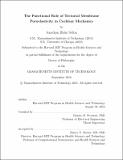The functional role of tectorial membrane poroelasticity in cochlear mechanics
Author(s)
Sellon, Jonathan Blake
DownloadFull printable version (20.64Mb)
Alternative title
Functional role of TM poroelasticity in cochlear mechanics
Other Contributors
Harvard--MIT Program in Health Sciences and Technology.
Advisor
Dennis M. Freeman.
Terms of use
Metadata
Show full item recordAbstract
The tectorial membrane (TM) is an extracellular matrix that overlies the mechanically sensitive hair bundles of sensory receptor cells in the inner ear. Based on this strategic position, it has long been accepted that the TM plays a critical role in the stimulation of sensory hair cells. Early measurements demonstrated elastic properties of the TM and suggested that the TM is resonant. More recent measurements have shown that longitudinal coupling of the TM generates traveling waves that contribute to cochlear tuning. Here we show the importance of (1) viscosity in controlling the spread of excitation in TM traveling waves, as well as the importance of matrix porosity in determining (2) the viscosity of genetically modified TMs, and (3) local interactions with hair bundles. To understand the longitudinal spread of mechanical excitation via TM traveling waves, we develop chemical manipulations that systematically and reversibly alter TM stiffness and viscosity. Increasing TM viscosity or decreasing stiffness reduces longitudinal spread of mechanical excitation, thereby coupling a smaller range of best frequencies, which would sharpen tuning. In contrast, increasing viscous loss or decreasing stiffness would tend to broaden tuning in resonance based TM models. Thus, TM wave and resonance mechanisms are fundamentally different in the way they control frequency selectivity. To understand the molecular origin of TM viscosity, we investigate traveling waves in genetically modified TMs. We show that nanoscale pores of TectaY1870C/+ TMs are significantly larger than those of Tectb -/- TMs. The larger pore size reduces shear viscosity, thereby reducing traveling wave speed and increasing spread of excitation. These results demonstrate the previously unrecognized importance of TM porosity in cochlear tuning. To understand how TM porosity affects the local interaction between the TM and hair cells, we apply oscillatory forces to the TM with spherical probe tips. The effective stiffness of the TM is small at low frequencies where the porous matrix and surrounding fluid can move independently. By contrast, the effective stiffness of the TM is large at high frequencies, where these two phases are entrained by viscosity to move together. Interestingly, the transition frequency is in the audio frequency range only for hair bundle sized tips. Furthermore, the transition region is characterized by increased phase lead between the stimulus force and applied displacement that may play an essential role in the stability of micromechanical feedback paths and ultimately the sensitivity of hearing. In conclusion, these results show that traveling wave properties and local interactions with the hair bundles depend critically on TM porosity, thus fundamentally changing the way we think about molecular mechanisms underlying cochlear frequency selectivity and sensitivity.
Description
Thesis: Ph. D., Harvard-MIT Program in Health Sciences and Technology, 2016. This electronic version was submitted by the student author. The certified thesis is available in the Institute Archives and Special Collections. Cataloged from student-submitted PDF version of thesis. Includes bibliographical references (pages 121-132).
Date issued
2016Department
Harvard University--MIT Division of Health Sciences and TechnologyPublisher
Massachusetts Institute of Technology
Keywords
Harvard--MIT Program in Health Sciences and Technology.